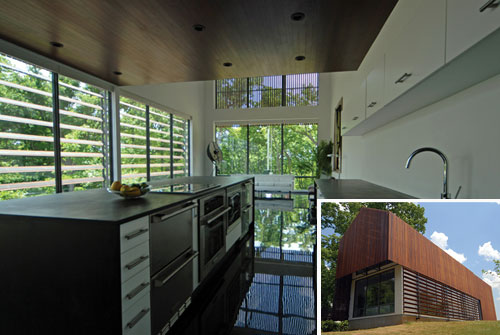Appliances for the Home: Sustainable Choices that Meet Accessibility and Lifestyle Needs
Energy-efficient Appliances for an |
Studio 804, a design/build program led by Dan Rockhill, AIA, at the University of Kansas School of Architecture and Urban Planning, completed the first LEED® Platinum Home in the Kansas City Metropolitan Area in 2009. The house is a fully self-sufficient "off-the-grid" prototype powered by photovoltaic solar panels and a residential wind turbine. Its donated ENERGY STAR appliances exceed federal standards by 20 percent for a side-by-side refrigerator (2009 model saves $300 per year compared with a 1980 model) and 83 percent for a front load washer (uses up to 56 percent less water than a conventional top load washer). The dishwasher uses less than five gallons of water per cycle. Cooking appliances include a microwave (no federal energy standard) and a hybrid electric cooktop with two induction elements and a full induction cooktop with all cooking elements being induction. Appliances contributed 3.0 points toward LEED Platinum certification: EA 9.1 High Efficiency Appliances: ENERGY STAR labeled refrigerator (1 point); ENERGY STAR labeled dishwasher that uses 6.0 gallons or less per cycle (0.5 point). ENERGY STAR labeled clothes washer (.5 point). EA 9.2 Water Efficient Clothes Washer: Clothes washer with modified energy factor (MEF) greater than 2.0 and water factor less than 5.5 (1 point). (Clothes washer installed has an MEF of 2.31 and a WF of 3.77.) |
|
| Photos: Studio 804 |
Â
Yet "smart" is more than addressing energy efficiency and accessibility standards. Forward thinking design professionals recognize that smart appliance design also serves today's multi-generational consumers and their multiple complex lifestyles. Smart is also about communication where user interface does not only occur between the consumer and appliance, but between the consumer and information - as one manufacturer's popular web-based interactive energy savings calculator confirms.
A recent television commercial shows a TV star dashing from wall oven to washer to dryer to dog to children as she cooks and does laundry at the same time. Even allowing for dramatic license, its message of needing to save time must resonate with adults who are holding down one or two jobs, often at home. Another commercial, albeit imaginary, could send an equally compelling message that smart appliance design is safer for the aging baby boomer whose vision and mobility are compromised. Â
 |
Touch screen control panel for a two-oven electric wall unit Photo: Electrolux Home Products, Inc. |
Â
Improved appliance ergonomics have benefitted people of all ages. Oven racks that extend fully with the touch of a finger and do not tip even when all are fully extended, dishwasher doors that stay at any angle they are placed, and three tiers of easy-to-reach freezer baskets are examples of manufacturers' response to today's consumer culture.
Smart appliance design also provides greater health benefits. With today's flu epidemics and antibiotic-resistant bacteria, dishwashers and washing machines with certified sanitized rinse cycles are increasingly valued.
It is, therefore, critical that design professionals understand the new technologies and features that contribute to appliance sustainability, rather than specify a product merely because it carries the appropriate energy efficiency sticker.










